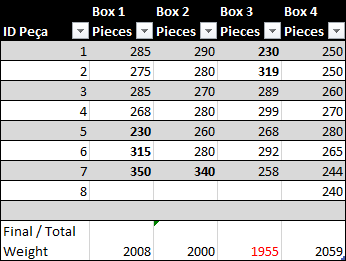A sort of template for experimenting with.
Code:
#include <iostream>
#include <iomanip>
#include <algorithm>
#include <vector>
#include <cstring>
#include <ctime>
#include <random>
using namespace std;
// Compile with g++ -std=c++11 foo.cpp
const int numBins = 12;
const int lowCapacity = 2000;
const int highCapacity = 2030;
void fillConveyorBelt(vector<int> &belt, int count = 1) {
const int distribution[] = {
2,7,19,34,24,7,3,2,2
};
const int baseWeight = 201;
const int intervalWeight = 19;
for ( int c = 0 ; c < count ; c++ ) {
for ( size_t i = 0 ; i < sizeof(distribution)/sizeof(distribution[0]) ; i++ ) {
int low = baseWeight + i * (intervalWeight+1);
int high= low + intervalWeight;
//cout << low << " " << high << " " << distribution[i] << endl;
std::default_random_engine gen(time(NULL));
std::uniform_int_distribution<int> dist(low,high);
for ( int n = 0 ; n < distribution[i] ; n++ ) {
belt.push_back(dist(gen));
}
}
}
}
class bin {
vector< vector<int> > bins;
vector<int> capacity;
public:
bin() :
bins(numBins,vector<int>()),
capacity(numBins,0)
{
}
// add a piece to a bin, returning true if it was fitted.
bool addPiece(int binNumber, int piece) {
if ( checkPieceWillFit(binNumber,piece) ) {
bins[binNumber].push_back(piece);
capacity[binNumber] += piece;
return true;
} else {
return false;
}
}
// true if the piece will fit in a given bin
bool checkPieceWillFit(int binNumber, int piece) {
return capacity[binNumber] + piece <= highCapacity;
}
// true if the bin is optimally full
bool binReadyForDispatch(int binNumber) {
return capacity[binNumber] >= lowCapacity && capacity[binNumber] <= highCapacity;
}
// find the bin which is most empty
int emptiestBin() {
int empty = highCapacity;
int id = 0;
for ( int i = 0 ; i < numBins ; i++ ) {
if ( capacity[i] < empty ) {
empty = capacity[i];
id = i;
}
}
return id;
}
// Find the bin which is most full
int fullestBin() {
int full = 0;
int id = 0;
for ( int i = 0 ; i < numBins ; i++ ) {
if ( capacity[i] > full ) {
full = capacity[i];
id = i;
}
}
return id;
}
// The bin is judged to be full, so output the details and make it empty
void dispatchBin(int binNumber) {
cout << binNumber << "=" << capacity[binNumber] << ":";
for ( size_t i = 0 ; i < bins[binNumber].size(); i++ ) {
cout << bins[binNumber][i] << " ";
}
cout << endl;
capacity[binNumber] = 0;
bins[binNumber].resize(0);
}
};
// Fill the bins in strict rotation
class linear : public bin {
int binNumber;
public:
linear() :
binNumber(0)
{
}
void addPiece(int piece) {
if ( bin::addPiece(binNumber,piece) ) {
;
} else {
// bin was full, empty it and add the piece
dispatchBin(binNumber);
bin::addPiece(binNumber,piece);
}
binNumber = (binNumber + 1) % numBins;
}
};
// Best fit (bin with highest capacity)
// Worst fit (bin with lowest capacity)
// Probable fit (use cumulative histogram of all seen pieces to estimate the best bin)
int main ( ) {
vector<int> belt;
fillConveyorBelt(belt,100);
shuffle(belt.begin(),belt.end(),std::default_random_engine(time(NULL)));
cout << belt.size() << endl;
linear l;
for ( int i = 0 ; i < 300 ; i++ ) {
l.addPiece(belt[i]);
}
}
Having filled the conveyor belt with thousands of items matching your distribution profile, you can experiment with pulling items off the belt one at a time and trying different strategies for filling the bins.





